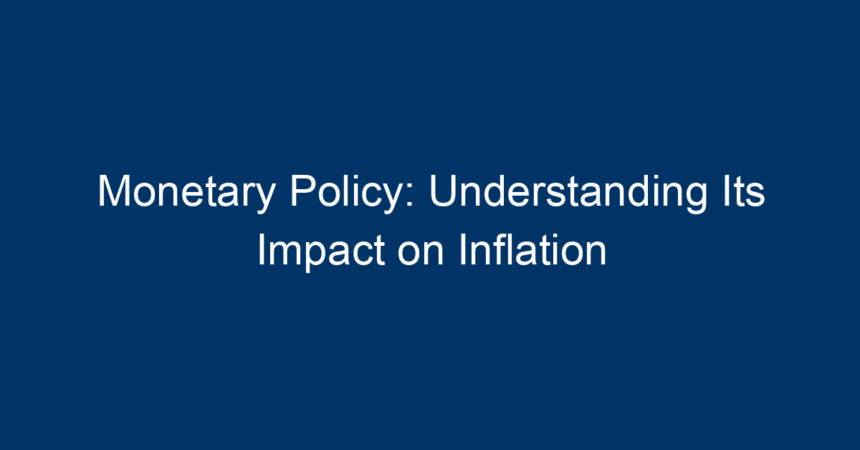Introduction
In the complex world of economics, few subjects are as critical as monetary policy. Defined as the actions taken by a country’s central bank to manage its money supply and interest rates, monetary policy holds the keys to understanding inflation, economic growth, and overall financial stability. This article will delve into how monetary policy influences inflation, exploring its mechanisms, historical context, and real-world examples. Whether you’re a student of economics, a business owner, or simply someone interested in financial affairs, grasping the nuances of monetary policy is essential for navigating today’s economic landscape.
What is Monetary Policy?
Monetary policy is primarily concerned with controlling the supply of money in an economy, thereby influencing interest rates, inflation, and employment. It can be categorized into two major types:
-
Expansionary Monetary Policy: This involves increasing the money supply to stimulate economic growth. Lowering interest rates and purchasing government securities are typical methods used to implement this policy. It’s often employed during periods of recession or economic slowdown.
- Contractionary Monetary Policy: Conversely, this policy aims to reduce the money supply to combat inflation. Increasing interest rates and selling government securities are its main strategies. This approach is generally adopted when inflation rates exceed desired levels.
The Link Between Monetary Policy and Inflation
How Monetary Policy Affects Inflation
Understanding how monetary policy affects inflation requires a look at the money supply and its relationship to consumer demand. When the central bank adopts an expansionary monetary policy:
- Increased Money Supply: More money in circulation typically leads to higher spending by consumers and businesses.
- Demand-Pull Inflation: As demand outstrips supply, prices begin to rise, causing inflation. This situation often occurs in improving economies where optimism leads to higher spending.
In contrast, when contractionary monetary policy is employed:
- Reduced Money Supply: Less money circulating leads to decreased consumer spending.
- Cost-Push Inflation: If production costs rise (due to higher prices for materials, for example), businesses may pass these costs onto consumers, resulting in higher prices.
Understanding these dynamics is crucial for policymakers, businesses, and individuals interested in economic stability.
Historical Perspectives on Monetary Policy and Inflation
Historically, the effectiveness of monetary policy in controlling inflation has been both praised and criticized. For instance:
-
The 1970s Stagflation: During this decade, many economies faced stagnant growth and high inflation, a combination not previously seen. Central banks struggled to implement effective monetary policies, leading to widespread discontent and economic hardship.
- The Volcker Shock: In the early 1980s, U.S. Federal Reserve Chairman Paul Volcker raised interest rates dramatically to combat runaway inflation, which reached nearly 14%. While this severe contraction led to a recession, it ultimately helped stabilize prices and restore public confidence in monetary policy.
These historical instances illustrate the delicate balance central banks must maintain and the long-term impacts of their monetary policy decisions.
Tools of Monetary Policy
To effectively manage inflation, central banks employ several tools:
1. Interest Rates
Interest rates dictate the cost of borrowing and the return on savings. Lowering interest rates encourages borrowing and spending, stimulating the economy. Conversely, raising rates can curb inflation by slowing down spending and investment.
2. Open Market Operations
Through open market operations, central banks buy or sell government securities to influence the available money supply. Purchasing securities injects money into the economy, making borrowing cheaper. Selling securities withdraws liquidity, reducing inflationary pressure.
3. Reserve Requirements
Banks are required to keep a certain percentage of deposits in reserve. Lowering reserve requirements increases the amount of money banks can lend, thereby increasing the money supply. Raising these requirements constrains lending and helps combat inflation.
4. Quantitative Easing
In times of economic downturn, central banks may resort to quantitative easing to boost the economy. This involves purchasing long-term securities to lower interest rates and increase the money supply directly.
Current Trends in Monetary Policy and Inflation
The Impact of COVID-19
The COVID-19 pandemic prompted unprecedented monetary policies worldwide. To counteract the economic slowdown, many central banks implemented aggressive expansionary monetary policies. As a result, significant amounts of money entered the economy, leading to rising inflation rates in many countries as demand soared post-lockdown.
Inflationary Pressures in 2023
As we transition into 2023, many economies are grappling with persistent inflationary pressures. Central banks, particularly in the United States and Europe, have begun to tighten monetary policy by increasing interest rates to contain inflation. The ongoing global supply chain disruptions and rising energy prices further complicate these efforts, making the task even more challenging.
The Role of Expectations in Monetary Policy
Inflation Expectations
Expectations about future inflation can significantly influence current economic behavior. If consumers and businesses believe that prices will continue to rise, they may accelerate their spending, leading to higher inflation.
Central banks employ various strategies to manage these expectations, including transparent communication and forward guidance. By clearly articulating their monetary policy intentions, they can help anchor inflation expectations and prevent a self-fulfilling inflation cycle.
Conclusion: Key Takeaways
Monetary policy is a powerful tool that can significantly influence inflation and overall economic stability. Here are some actionable insights to keep in mind:
-
Stay Informed: Understanding the principles of monetary policy can help individuals and businesses navigate economic fluctuations more effectively.
-
Monitor Central Bank Announcements: Central banks’ decisions regarding interest rates and other monetary policies can impact investment and spending behavior.
- Consider Inflation in Planning: Businesses should incorporate potential inflationary trends into their pricing and budgeting strategies.
In a world where economic conditions can shift rapidly, the ability to comprehend and react to monetary policy is invaluable. By staying informed and adaptable, you can make more strategic financial decisions, whether for personal finance or business growth. Recognizing the intertwining relationship between monetary policy and inflation not only empowers individuals and businesses to better navigate economic landscapes but also promotes informed citizenship and economic awareness.




